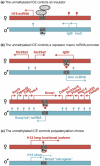Genomic imprinting-an epigenetic gene-regulatory model
- PMID: 20153958
- PMCID: PMC2860637
- DOI: 10.1016/j.gde.2010.01.009
Genomic imprinting-an epigenetic gene-regulatory model
Abstract
Epigenetic mechanisms (Box 1) are considered to play major gene-regulatory roles in development, differentiation and disease. However, the relative importance of epigenetics in defining the mammalian transcriptome in normal and disease states is unknown. The mammalian genome contains only a few model systems where epigenetic gene regulation has been shown to play a major role in transcriptional control. These model systems are important not only to investigate the biological function of known epigenetic modifications but also to identify new and unexpected epigenetic mechanisms in the mammalian genome. Here we review recent progress in understanding how epigenetic mechanisms control imprinted gene expression.
2010 Elsevier Ltd. All rights reserved.
Figures


Similar articles
-
[Epigenetic regulation of genomic imprinting in germline cells and preimplantation embryos].Yi Chuan. 2016 Feb;38(2):103-8. doi: 10.16288/j.yczz.15-194. Yi Chuan. 2016. PMID: 26907773 Review. Chinese.
-
Epigenetic reprogramming in mammalian development.Science. 2001 Aug 10;293(5532):1089-93. doi: 10.1126/science.1063443. Science. 2001. PMID: 11498579 Review.
-
Imprinting and the epigenetic asymmetry between parental genomes.Science. 2001 Aug 10;293(5532):1086-9. doi: 10.1126/science.1064020. Science. 2001. PMID: 11498578
-
Imprinting and epigenetic changes in the early embryo.Mamm Genome. 2009 Sep-Oct;20(9-10):532-43. doi: 10.1007/s00335-009-9225-2. Epub 2009 Sep 16. Mamm Genome. 2009. PMID: 19760320 Review.
-
Genomic imprinting and epigenetic control of development.Cold Spring Harb Perspect Biol. 2012 Jul 1;4(7):a008136. doi: 10.1101/cshperspect.a008136. Cold Spring Harb Perspect Biol. 2012. PMID: 22687277 Free PMC article.
Cited by
-
Searching for parent-of-origin effects on cardiometabolic traits in imprinted genomic regions.Eur J Hum Genet. 2020 May;28(5):646-655. doi: 10.1038/s41431-019-0568-1. Epub 2020 Jan 2. Eur J Hum Genet. 2020. PMID: 31896779 Free PMC article.
-
DNA methylation in endometriosis (Review).Mol Med Rep. 2016 Apr;13(4):2939-48. doi: 10.3892/mmr.2016.4925. Epub 2016 Feb 22. Mol Med Rep. 2016. PMID: 26934855 Free PMC article. Review.
-
Transcription driven somatic DNA methylation within the imprinted Gnas cluster.PLoS One. 2015 Feb 6;10(2):e0117378. doi: 10.1371/journal.pone.0117378. eCollection 2015. PLoS One. 2015. PMID: 25659103 Free PMC article.
-
Long noncoding RNAs in imprinting and X chromosome inactivation.Biomolecules. 2014 Jan 7;4(1):76-100. doi: 10.3390/biom4010076. Biomolecules. 2014. PMID: 24970206 Free PMC article. Review.
-
Sex dimorphic associations of Prader-Willi imprinted gene expressions in umbilical cord with prenatal and postnatal growth in healthy infants.World J Pediatr. 2025 Jan;21(1):100-112. doi: 10.1007/s12519-024-00865-4. Epub 2025 Jan 22. World J Pediatr. 2025. PMID: 39838229 Free PMC article.
References
-
- Carninci P. Is sequencing enlightenment ending the dark age of the transcriptome? Nat Methods. 2009;6:711–713. - PubMed
-
- Allis CD, Jenuwein T, Reinberg D. In: Epigenetics. edn 1. Marie-Laure Caparros AE, editor. Cold Spring Harbor Laboratory Press; New York: 2007.
-
-
Berger SL, Kouzarides T, Shiekhattar R, Shilatifard A. An operational definition of epigenetics. Genes Dev. 2009;23:781–783. The results of a meeting hosted by the Banbury Conference Center and Cold Spring Harbor Laboratory that discussed epigenetic control of genomic function reached a consensus definition of “epigenetics” to be considered by the broader community based on multiple mechanistic steps leading to the stable heritance of the epigenetic phenotype.
-
Publication types
MeSH terms
Grants and funding
LinkOut - more resources
Full Text Sources

